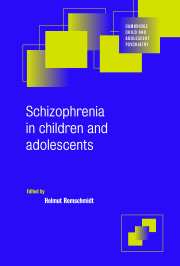Book contents
- Frontmatter
- Contents
- List of contributors
- Preface
- 1 Childhood psychosis and schizophrenia: a historical review
- 2 Definition and classification
- 3 Epidemiology of early onset schizophrenia
- 4 Childhood schizophrenia: developmental aspects
- 5 Diagnosis and differential diagnosis
- 6 Genetic aspects
- 7 Neurobehavioral perspective
- 8 Psychosocial factors: the social context of child and adolescent onset schizophrenia
- 9 Treatment and rehabilitation
- 10 Course and prognosis
- Index
Preface
Published online by Cambridge University Press: 23 October 2009
- Frontmatter
- Contents
- List of contributors
- Preface
- 1 Childhood psychosis and schizophrenia: a historical review
- 2 Definition and classification
- 3 Epidemiology of early onset schizophrenia
- 4 Childhood schizophrenia: developmental aspects
- 5 Diagnosis and differential diagnosis
- 6 Genetic aspects
- 7 Neurobehavioral perspective
- 8 Psychosocial factors: the social context of child and adolescent onset schizophrenia
- 9 Treatment and rehabilitation
- 10 Course and prognosis
- Index
Summary
Schizophrenic psychoses in childhood are important but rare disorders within the spectrum of psychoses. They become increasingly common during adolescence and the symptomatology with age becomes increasingly similar to the adult disorder. After Kraepelin (1893) first described dementia praecox and Bleuler (1911) introduced the term “schizophrenia,” Homburger (1926) asserted the existence of childhood schizophrenia in his classic textbook and described some characteristic features of the disorder including those today known as “negative symptoms.”
Kanner (1943) and Asperger (1944) differentiated the meanwhile well-known autistic syndromes (early infantile autism and autistic personality disorder) from the pool of the childhood psychoses. Finally, Leonhard's work is worthy of note (1986). He emphasized that schizophrenic psychoses comprise a very heterogeneous group of disorders, and that it was an illusion to think that one could find a unique etiology in schizophrenia. Unlike many other authors, he subdivided the schizophrenic disorders into unsystematic and systematic schizophrenias. According to this classification, unsystematic schizophrenias are characterized by primarily affective symptoms (e.g., extreme anxiety states, delusions, hallucinations, ideas of reference) with an acute, sometimes periodic course and periods of good remission. They have more in common with affective psychoses than with the group of systematic schizophrenias. Systematic schizophrenias show predominantly cognitive disturbances and disturbances of voluntary functions. Their course is generally chronic without recovery to former cognitive levels and the prognosis is poor. As a special form of childhood schizophrenia, Leonhard distinguishes early infantile catatonia, which is characterized by motor symptoms, absent or poor language development, circumscribed intellectual impairments, negativism, a periodic course, and dominance amongst males.
- Type
- Chapter
- Information
- Schizophrenia in Children and Adolescents , pp. xiii - xviPublisher: Cambridge University PressPrint publication year: 2000

